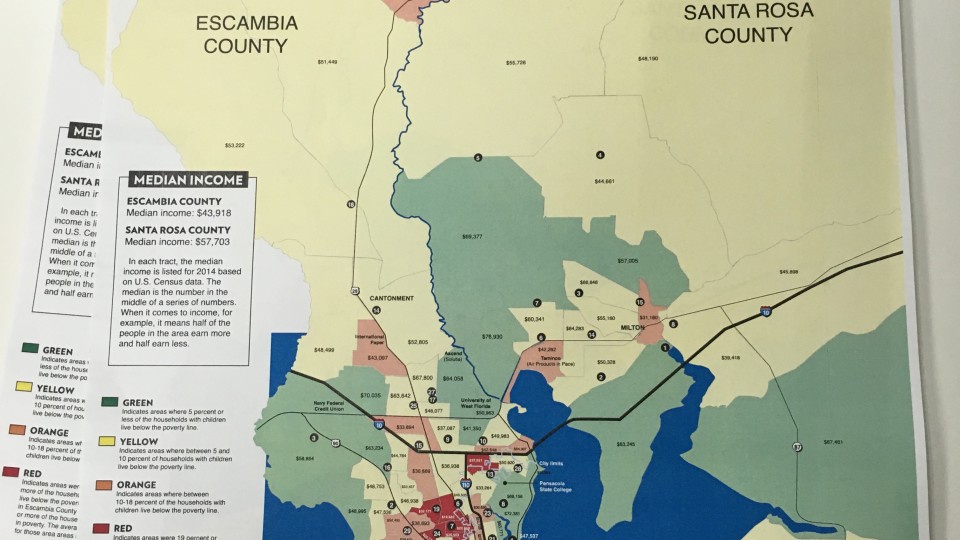We live our economic lives together
- December 7, 2015
- / Randy Hammer
- / education

The Studer Community Institute's Pockets of Poverty report.
Shannon Nickinson, Rick Harper and I talked at Five Flags Rotary today about Studer Community Institute’s recent “Pockets of Poverty” report and our updated Pensacola Metro Dashboard.
Harper talked about how 90 percent of workers who live in Escambia also work in Escambia. Over in Santa Rosa, 49 percent of workers cross the county line to work. Harper made the point to stress how interconnected Escambia and Santa Rosa counties are.
“We live our economic lives together,” he said.
If we truly want to improve the poverty rate and improve Escambia’s quality of life, Harper also said we must do a better job of “ensuring a quality education for our children.”
Triumph Gulf Coast Inc., a nonprofit corporation created by the legislature to help the eight Panhandle counties manage the economic damages money from the BP oil-spill settlement.
The settlement could provide the eight counties with $56 million a year for 30 years. Portions of that money could help fund “transformational projects” to improve kindergarten readiness, high school graduation rates and workforce development, said Harper.
A consistent question I receive when I talk to groups is why people who don’t have children in school should care about high school graduation rates?
Nickinson had a strong piece about graduation rates that ran on the Institute’s website and in Sunday’s Pensacola News Journal.
She referenced a study by Auburn University at Montgomery economist, Kaivan Deravi, who researched the economic impact of increasing Alabama’s high school graduation rate. He looked at what it would mean if 90 percent of high school students graduating on time. His findings:
— Steady progress toward that goal of 90 percent would bring higher employment, earnings and tax revenue because of rising educational attainment.
- — By 2020, if the goal is achieved, the state’s economic output would increase by $430 million as a result of more graduates, and revenues in the Education Trust Fund would grow by $22 million.
— Each subsequent graduating class would add nearly 1,200 direct jobs to Alabama’s economy. Every class with a 90 percent graduation rate would collectively earn $68 million more annually than a class with an 80 percent graduation rate.
“Florida is not Alabama,” said Nickinson, “but it is a good bet that the lack of educational attainment in our workforce is money we are missing out on.”
During the Q&A session, Rotary members Robert DeVarona and Dick Appleyard asked if the Institute would be doing further research into kindergarten readiness. In Escambia County, only 66 percent of children who show up on the first day of school are ready for kindergarten.
Indeed, the Institute’s next major report in early February will look at kindergarten readiness and programs locally and nationally that are making a difference.
 CivicCon launches with a look at good growth in cities
CivicCon launches with a look at good growth in cities
 Building stronger brains one baby, one parent at a time
Building stronger brains one baby, one parent at a time
 SCI debuts commercial on Early Learning City
SCI debuts commercial on Early Learning City
 Entrecon: World class speakers and an opportunity to sharpen skills
Entrecon: World class speakers and an opportunity to sharpen skills
 PYP Quality of Life survey 2017
PYP Quality of Life survey 2017
 EntreCon Pensacola 2016: A look back
EntreCon Pensacola 2016: A look back
 Leadership tip: getting better employee takeaways
Leadership tip: getting better employee takeaways
 Leadership tip: be interested instead of interesting
Leadership tip: be interested instead of interesting
 Leadership tip: delivering difficult messages
Leadership tip: delivering difficult messages
 Brain Bags boost Arc, Early Childhood Court programs
Brain Bags boost Arc, Early Childhood Court programs